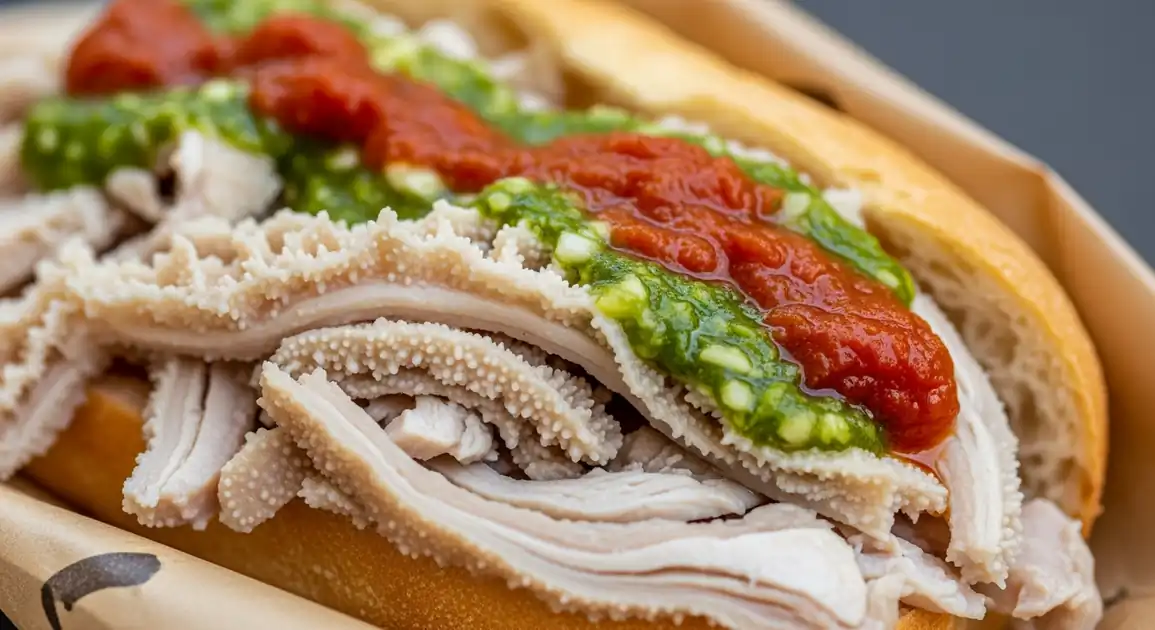Lampredotto
Lampredotto

Description
Florence (Firenze) is the undisputed home of lampredotto, where this tripe sandwich remains an essential part of local food culture. From historic vendors who've operated for generations to new artisanal stands, lampredotto is a fundamental culinary experience in the Tuscan capital. The city maintains dozens of dedicated 'trippai' (tripe vendors) scattered throughout its neighborhoods, each with loyal customers who debate the merits of different preparations.
Dietary Information
Serving information
Serving style
Served in parchment paper or wax paper wrapping. Eaten standing at the counter ('al banco') or taken to nearby piazzas. Typically eaten immediately while hot.
Quick facts
Safety Tips
What to Look For
-
Meat actively cooking in broth
Properly prepared lampredotto should be visibly cooking in a simmering broth, ensuring it maintains safe temperatures and remains moist.
-
Fresh, bright herb sauce (salsa verde)
Quality salsa verde should be vibrant green, indicating freshness. Dull, brownish sauce may be old.
-
Clean workspace and utensils
Observe the vendor's cleanliness, including the cutting board, knives, and serving area.
-
High turnover and local customers
Busy stands with regular local clientele typically ensure fresh preparation and proper food handling.
-
Separate money and food handling
Better vendors will avoid touching money and food without washing hands or using gloves in between.
What to avoid
-
Pre-sliced meat sitting out not in broth
Lampredotto should be kept in its cooking liquid until serving to maintain both food safety and quality.
-
Vendors with no visible cooking pot
Authentic lampredotto is served from its cooking vessel. Be wary of vendors who aren't cooking on-site.
-
Dirty or disorganized preparation area
Food safety concerns increase with poor hygiene practices.
-
Grey or off-colored meat
Properly cooked lampredotto should be pinkish-brown. Discoloration may indicate old meat.
-
Bread that looks stale or meat that looks dry
Both are signs that ingredients aren't fresh or have been sitting out too long.
Price information
Price range
Budget tips
- Traditional street vendors ('trippai') offer the best value at 4-5 EUR per sandwich.
- Mercato Centrale vendors may charge 5-7 EUR but are convenient for tourists.
- Some newer 'gourmet' lampredotto stands charge 6-8 EUR for special preparations.
- Avoid places primarily targeting tourists - prices should never exceed 8 EUR for a standard sandwich.
- Some vendors offer a small glass of wine included in the price - good value.
Value indicators
- Generous portion of meat that extends to the edges of the bread.
- Freshly made salsa verde with visible herb pieces.
- Bread properly soaked in broth ('bagnato').
- Vendor who takes time to prepare rather than rushing.
- Additional broth served on the side upon request.
Where to Find This Dish
Mercato Centrale
The historic covered market houses several famous lampredotto vendors, particularly on the ground floor.
Da Nerbone stand, Mario Cattaneo stand
Morning, Lunch
Piazza de' Cimatori
Home to the famous Trippaio del Porcellino, one of the city's most renowned lampredotto stands.
Loggia del Porcellino, Via dei Cimatori
Lunch, Afternoon
Sant'Ambrogio
This less touristy area has excellent vendors both inside and outside the market.
Mercato di Sant'Ambrogio, Via de' Macci
Morning, Lunch
San Frediano
This authentic neighborhood across the Arno river has traditional lampredotto stands favored by locals.
Piazza dei Nerli, Via di Santo Spirito
Lunch
Vendor Tips
- Ask for your bread to be well-soaked in broth ('ben bagnato') for the full experience.
- When vendors ask 'Con tutto?' they're asking if you want all available sauces.
- Some vendors offer a small plastic cup of extra cooking broth - great for dipping.
- The more established vendors sometimes close early when they sell out - aim for before 2 PM.
How to Order
Regional Variations
-
Lampredotto Doppio
(Lampredotto Doppio)
Double portion of meat for the especially hungry, offered by many Florentine vendors for 1-2 EUR extra.
-
Crostini di Lampredotto
(Crostini di Lampredotto)
A Florentine appetizer version - small toasts topped with chopped lampredotto, found in some traditional restaurants.
-
Lampredotto con Bagnacauda
(Lampredotto con Bagnacauda)
A fusion variation found at some innovative vendors, incorporating the anchovy-garlic sauce from Piedmont.
-
Lampredotto al Sugo
(Lampredotto al Sugo)
A saucier preparation popular in some Florentine eateries, where the tripe is further cooked in tomato sauce.
Cultural context
History
Dating back to the Renaissance, lampredotto has deep roots in Florence's 'cucina povera' (poor people's cooking) tradition. The name likely derives from 'lampreda' (lamprey eel) which the cooked tripe supposedly resembles. Originally, tripe vendors ('trippai') wandered streets with mobile carts, serving workers who needed affordable, filling food. During the 15th-16th centuries, they were officially organized into a guild. Today, lampredotto has transcended its humble origins to become a celebrated culinary icon of Florence, sought out by both locals and culinary tourists.
Local significance
Lampredotto is a cornerstone of Florentine identity - a point of pride that distinguishes the city's cuisine from other Italian regions. It represents the 'what's humble can be sublime' philosophy of Tuscan cooking.
Eating customs
- Always eaten fresh and hot - never taken home for later.
- Using the paper wrapping to catch drips is expected.
- Acceptable to ask for extra broth ('più brodo') to moisten the sandwich.
- Traditional to have a small glass of Chianti wine with your lampredotto.